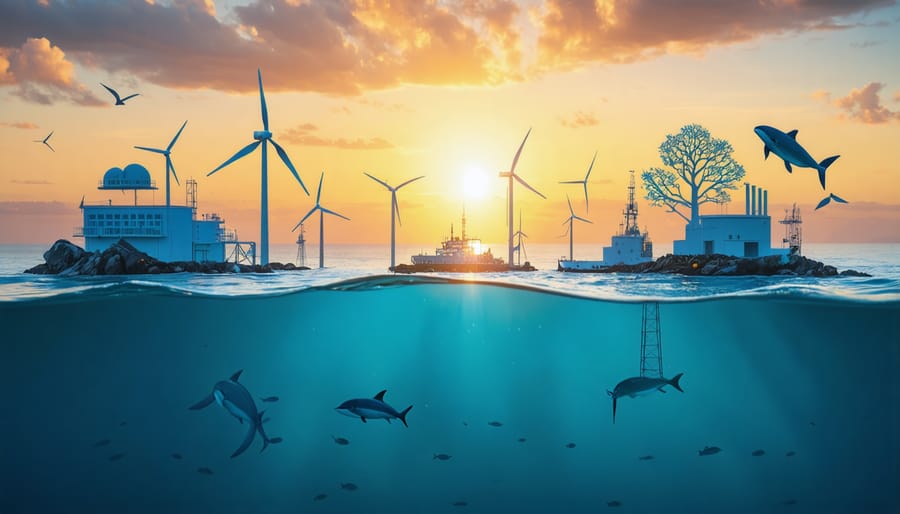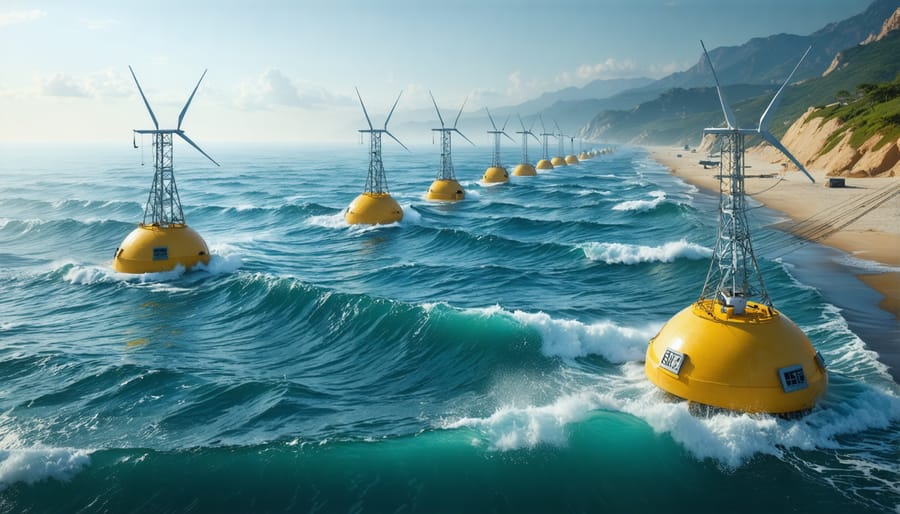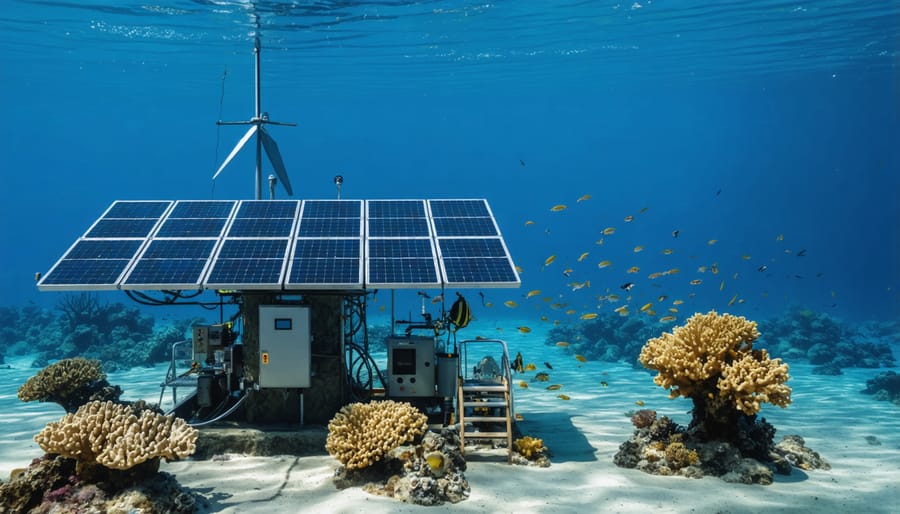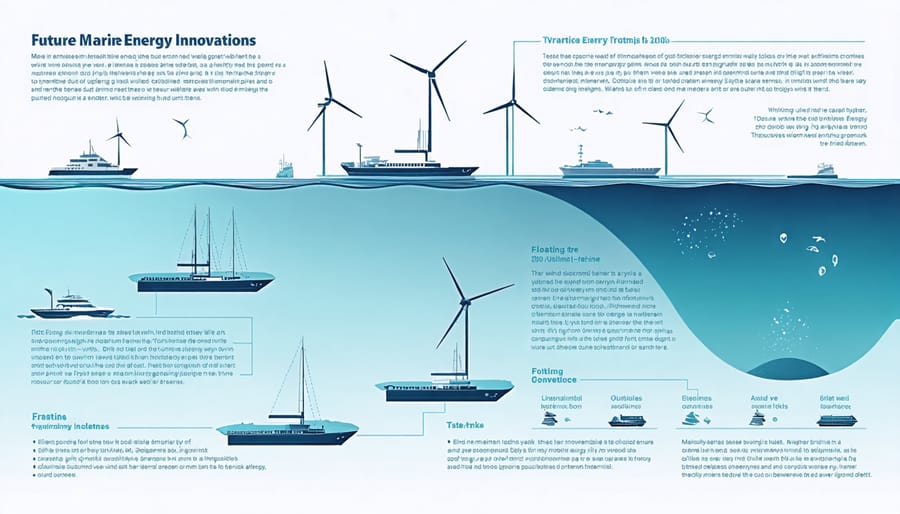
As our oceans surge with untapped potential, marine renewable energy emerges as a pivotal solution to our global energy crisis. From the rhythmic power of waves to the steady pull of tides, our seas hold enough energy to power millions of homes while addressing critical renewable energy challenges in marine conservation.
The convergence of advanced marine technology and sustainable energy production has opened new frontiers in clean power generation. Unlike traditional fossil fuels, marine renewable energy harnesses the ocean’s natural forces – tidal streams, waves, and thermal gradients – to generate electricity without depleting finite resources or contributing to climate change. This revolutionary approach not only promises to transform our energy landscape but also offers a sustainable path forward for coastal communities worldwide.
As we stand at the threshold of a blue energy revolution, innovative technologies like tidal turbines, wave energy converters, and ocean thermal energy conversion systems are proving that our seas can be both an ecological treasure and a renewable powerhouse. These developments represent not just technological achievements, but crucial steps toward a carbon-neutral future where energy production and marine conservation work in harmony.
Harnessing Ocean Power: Current Technologies
Wave Energy Converters
Wave Energy Converters (WECs) harness the ocean’s perpetual motion to generate clean electricity, offering promising solutions for marine research stations and coastal communities. These devices capture energy from surface waves through various mechanisms, including point absorbers, attenuators, and oscillating water columns.
Point absorbers, which resemble large buoys, move up and down with the waves, converting mechanical motion into electrical power through internal generators. Attenuators, like the famous Pelamis system, consist of connected segments that flex with wave motion, driving hydraulic pumps that generate electricity. Oscillating water columns create air pressure changes as waves move in and out of partially submerged chambers, driving turbines to produce power.
Marine research stations increasingly incorporate WECs into their power systems, reducing reliance on diesel generators and minimizing environmental impact. For example, the EMEC (European Marine Energy Centre) in Scotland uses various wave energy technologies to power their facilities while simultaneously conducting research on device efficiency and environmental effects.
These systems not only provide sustainable energy but also serve as artificial reefs, creating new habitats for marine life. However, careful environmental impact assessments ensure that WEC installations don’t disrupt migration patterns or sensitive marine ecosystems.

Tidal Energy Systems
Tidal energy systems harness the predictable power of ocean tides to generate clean, renewable electricity. These systems play a crucial role in powering marine conservation equipment, from underwater monitoring stations to research vessels. Unlike solar or wind energy, tidal power offers reliable generation cycles, making it particularly valuable for continuous operation of critical conservation infrastructure.
Two main types of tidal energy systems are commonly used in marine conservation: tidal stream generators, which function like underwater wind turbines, and tidal barrage systems, which operate similarly to hydroelectric dams. Conservation teams often deploy smaller-scale tidal stream devices to power remote monitoring equipment, as these systems can be strategically positioned in areas with strong tidal currents without significantly disrupting marine ecosystems.
Marine scientists have successfully integrated tidal energy systems with coral reef monitoring stations and marine mammal tracking devices. For example, in the Great Barrier Reef, tidal-powered sensors continuously monitor water quality and temperature changes, providing vital data for conservation efforts. These self-sustaining power systems eliminate the need for frequent battery replacements, reducing maintenance visits and minimizing human impact on sensitive marine environments.
Ocean Thermal Energy
Ocean Thermal Energy Conversion (OTEC) harnesses the temperature difference between deep and surface ocean waters to generate clean electricity. This innovative technology has particular significance for marine research facilities, which often operate in remote locations where conventional power sources are impractical. OTEC systems use warm surface water to vaporize a working fluid, which drives a turbine to generate power, while cold deep water recondenses the fluid to complete the cycle.
Beyond power generation, OTEC facilities offer unique opportunities for marine research. The continuous pumping of nutrient-rich deep ocean water creates artificial upwelling zones, supporting marine life and enabling scientists to study deep-sea ecosystems. Several research stations worldwide have successfully integrated OTEC technology, combining sustainable energy production with marine biology research, water desalination, and aquaculture projects.
While implementation costs remain high, OTEC’s potential for supporting self-sustaining marine research operations makes it an increasingly attractive option for coastal and island facilities.
Conservation Success Stories
Coral Reef Monitoring Stations
In recent years, innovative coral reef monitoring stations have emerged as powerful tools for marine conservation, combining renewable energy with cutting-edge technology. These self-powered stations represent a significant advancement in our ability to track and protect coral reef ecosystems while maintaining a minimal environmental footprint.
The monitoring stations harness a combination of wave, solar, and tidal energy to power sophisticated sensors and AI-powered monitoring systems. Each station typically includes temperature sensors, pH meters, and high-resolution cameras that continuously collect data about coral health, water quality, and marine biodiversity.
Dr. Sarah Chen, a marine biologist leading the Coral Watch Project in the Great Barrier Reef, shares her experience: “These self-powered stations have revolutionized our understanding of coral reef dynamics. We can now monitor changes in real-time without frequent physical interventions, which helps minimize human impact on these delicate ecosystems.”
The stations are designed to withstand harsh marine conditions while generating enough power to operate continuously. A typical station can produce between 2-5 kW of electricity daily, depending on environmental conditions, which is sufficient to power its monitoring equipment and transmit data to research centers on shore.
The success of these monitoring stations has inspired a growing network of citizen scientists and volunteers who help maintain and monitor the systems. Through organized programs, community members can participate in data collection and analysis, creating a broader understanding of coral reef conservation while contributing to vital research efforts.
These self-sustained monitoring stations demonstrate how renewable marine energy can support critical conservation efforts while promoting community engagement in marine science.

Marine Research Laboratories
Several pioneering research facilities are leading the way in harnessing renewable marine energy while advancing our understanding of ocean ecosystems. The European Marine Energy Centre (EMEC) in Scotland’s Orkney Islands stands out as a prime example, combining wave and tidal energy systems with advanced ocean monitoring networks to study marine life patterns around energy installations.
The Pacific Marine Energy Center (PMEC), operating along the Oregon coast, has developed a unique approach by integrating floating wind turbines with research platforms that monitor whale migration patterns and fish populations. Their innovative design allows marine biologists to conduct long-term studies while the facility generates clean energy for coastal communities.
In Japan, the Okinawa Institute of Science and Technology’s Marine Energy Research Center has pioneered a hybrid system combining thermal energy conversion with biodiversity monitoring stations. Their floating laboratories use the energy generated from temperature differences in ocean waters to power research equipment and data collection systems.
The Blue Energy Centre in Nova Scotia, Canada, demonstrates how tidal energy can support marine research operations. Their facility uses adaptive turbine technology that automatically adjusts to protect marine life while maintaining energy production. This approach has enabled unprecedented studies of how marine species interact with renewable energy infrastructure.
These facilities not only advance our understanding of marine renewable energy but also serve as floating laboratories where scientists can study ocean health, climate change impacts, and marine ecosystem dynamics in real-time, all powered by the very energy sources they’re researching.
Environmental Impact Assessment
Benefits for Marine Life
Renewable marine energy installations can create unexpected sanctuaries for marine life, offering numerous benefits to ocean ecosystems. These structures often act as artificial reefs, providing new habitats for various marine species, from small invertebrates to larger fish populations. Research has shown that offshore wind farms and tidal energy devices can become thriving marine ecosystems within just a few years of installation.
The presence of these installations often leads to the creation of de facto marine protected areas, as fishing activities are typically restricted around the infrastructure. This protection allows fish populations to recover and thrive, creating spillover effects that benefit adjacent fishing grounds. Marine mammals, particularly seals, have been observed using wave energy converters as resting spots and feeding stations.
Studies in European waters have documented increased biodiversity around marine renewable energy sites, with some installations hosting up to 200% more species compared to surrounding areas. The underwater portions of these structures provide attachment points for filter-feeding organisms like mussels and barnacles, which in turn attract other marine life up the food chain.
Additionally, marine renewable energy projects often require comprehensive environmental monitoring programs, generating valuable data about marine ecosystems that aids conservation efforts. This increased understanding helps scientists and conservationists better protect vulnerable marine species and their habitats while developing more environmentally sensitive energy solutions.
Mitigation Strategies
To minimize the environmental impact of marine renewable energy installations, developers and scientists have implemented various effective strategies. These approaches focus on protecting marine life while maintaining optimal energy production.
Sound-dampening technologies play a crucial role in reducing noise pollution during construction and operation. Advanced foundation designs incorporate noise reduction systems, while “bubble curtains” create barriers that minimize sound propagation through water, protecting sensitive marine species from acoustic disturbance.
Strategic timing of installation activities helps protect marine mammals during migration seasons. By scheduling construction during periods of lower marine activity, developers significantly reduce the risk of disrupting crucial biological processes like breeding and feeding.
Smart design features include wildlife-friendly turbine blades with slower rotation speeds and wider spacing between blades, reducing the risk of collision for marine life. Some installations incorporate escape routes and protective screens to prevent marine organisms from becoming trapped in equipment.
Environmental monitoring systems use advanced sensors and cameras to detect approaching marine life, automatically adjusting or temporarily stopping operations when necessary. This adaptive management approach ensures immediate response to potential wildlife interactions.
Careful site selection remains one of the most effective mitigation strategies. By conducting thorough environmental impact assessments and choosing locations away from critical marine habitats, developers can significantly reduce potential negative effects on marine ecosystems while maintaining efficient energy production.
These strategies continue to evolve as new research provides better understanding of marine ecosystem interactions with renewable energy installations.

Future Innovations
The future of marine renewable energy holds tremendous promise, with innovative technologies poised to revolutionize how we harness ocean power while protecting marine ecosystems. Integration of marine robotics technology is enabling more precise deployment and maintenance of underwater turbines, significantly reducing their impact on marine life.
Emerging technologies include shape-shifting tidal turbines that automatically adjust their blade configurations based on marine animal presence, minimizing potential collisions with sea creatures. These smart systems use advanced sonar and AI to detect approaching marine mammals and fish, temporarily altering their operation to ensure safe passage.
Floating solar-wind hybrid platforms are being developed to maximize energy generation while minimizing ocean floor disruption. These innovative structures combine the benefits of offshore wind power with solar technology, creating energy hubs that can also serve as artificial reefs, promoting marine biodiversity.
Scientists are also exploring bio-inspired designs, such as kelp-like wave energy converters that sway with ocean currents, mimicking natural marine vegetation. These systems show promise in generating power while providing habitat structures for marine species.
Research is underway on zero-impact foundations that can be installed and removed without permanent seabed alterations. These modular systems use gravity-based anchoring methods and biodegradable materials, ensuring minimal long-term environmental impact.
Perhaps most exciting is the development of energy-harvesting artificial coral reefs. These structures combine wave energy conversion technology with reef restoration, providing both renewable power and critical habitat for marine species. Early trials show these systems can generate substantial power while supporting diverse marine communities.
Looking ahead, projects combining multiple technologies are expected to create marine energy parks that serve as both power generation facilities and marine conservation zones, demonstrating how renewable energy and ocean preservation can work in harmony.
As we look toward a sustainable future for our oceans, renewable marine energy stands as a beacon of hope in our conservation efforts. The technologies we’ve explored – from tidal turbines to wave energy converters – demonstrate the incredible potential for harnessing ocean power while preserving marine ecosystems. These innovations not only provide clean energy solutions but also create opportunities for marine habitat enhancement and biodiversity protection.
The success of renewable marine energy projects worldwide proves that we can balance our energy needs with environmental stewardship. From Scotland’s tidal arrays to Australia’s wave energy farms, these installations show how careful planning and environmental monitoring can lead to positive outcomes for both energy production and marine life.
However, the future of marine renewable energy depends on collective action and support. Whether you’re a scientist, student, educator, or concerned citizen, there are numerous ways to get involved. Consider joining local marine conservation groups, supporting research initiatives, or participating in citizen science projects that monitor marine ecosystems around energy installations.
The time to act is now. By embracing and advancing renewable marine energy technologies, we can contribute to a cleaner energy future while protecting our precious ocean ecosystems. Let’s work together to ensure that our pursuit of sustainable energy strengthens rather than compromises marine conservation efforts. Your involvement, whether through advocacy, education, or direct participation in marine energy projects, can help shape a more sustainable future for our oceans.
jessica
Ava Singh is an environmental writer and marine sustainability advocate with a deep commitment to protecting the world's oceans and coastal communities. With a background in environmental policy and a passion for storytelling, Ava brings complex topics to life through clear, engaging content that educates and empowers readers. At the Marine Biodiversity & Sustainability Learning Center, Ava focuses on sharing impactful stories about community engagement, policy innovations, and conservation strategies. Her writing bridges the gap between science and the public, encouraging people to take part in preserving marine biodiversity. When she’s not writing, Ava collaborates with local initiatives to promote eco-conscious living and sustainable development, ensuring her work makes a difference both on the page and in the real world.
